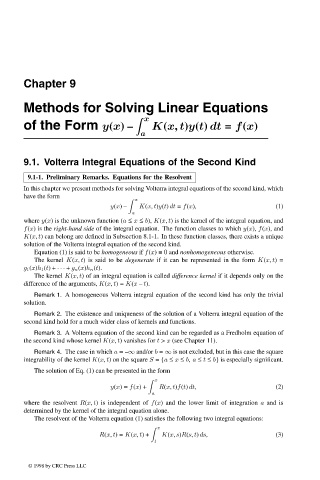Page 477 - Handbook Of Integral Equations
P. 477
Chapter 9
Methods for Solving Linear Equations
x
of the Form y(x)– K(x, t)y(t) dt = f(x)
a
9.1. Volterra Integral Equations of the Second Kind
9.1-1. Preliminary Remarks. Equations for the Resolvent
In this chapter we present methods for solving Volterra integral equations of the second kind, which
have the form
x
y(x)– K(x, t)y(t) dt = f(x), (1)
a
where y(x) is the unknown function (a ≤ x ≤ b), K(x, t) is the kernel of the integral equation, and
f(x) is the right-hand side of the integral equation. The function classes to which y(x), f(x), and
K(x, t) can belong are defined in Subsection 8.1-1. In these function classes, there exists a unique
solution of the Volterra integral equation of the second kind.
Equation (1) is said to be homogeneous if f(x) ≡ 0 and nonhomogeneous otherwise.
The kernel K(x, t) is said to be degenerate if it can be represented in the form K(x, t)=
g 1 (x)h 1 (t)+ ··· + g n (x)h n (t).
The kernel K(x, t) of an integral equation is called difference kernel if it depends only on the
difference of the arguments, K(x, t)= K(x – t).
Remark 1. A homogeneous Volterra integral equation of the second kind has only the trivial
solution.
Remark 2. The existence and uniqueness of the solution of a Volterra integral equation of the
second kind hold for a much wider class of kernels and functions.
Remark 3. A Volterra equation of the second kind can be regarded as a Fredholm equation of
the second kind whose kernel K(x, t) vanishes for t > x (see Chapter 11).
Remark 4. The case in which a =–∞ and/or b = ∞ is not excluded, but in this case the square
integrability of the kernel K(x, t) on the square S = {a ≤ x ≤ b, a ≤ t ≤ b} is especially significant.
The solution of Eq. (1) can be presented in the form
x
y(x)= f(x)+ R(x, t)f(t) dt, (2)
a
where the resolvent R(x, t) is independent of f(x) and the lower limit of integration a and is
determined by the kernel of the integral equation alone.
The resolvent of the Volterra equation (1) satisfies the following two integral equations:
x
R(x, t)= K(x, t)+ K(x, s)R(s, t) ds, (3)
t
© 1998 by CRC Press LLC
© 1998 by CRC Press LLC
Page 459

